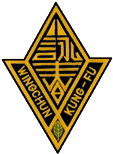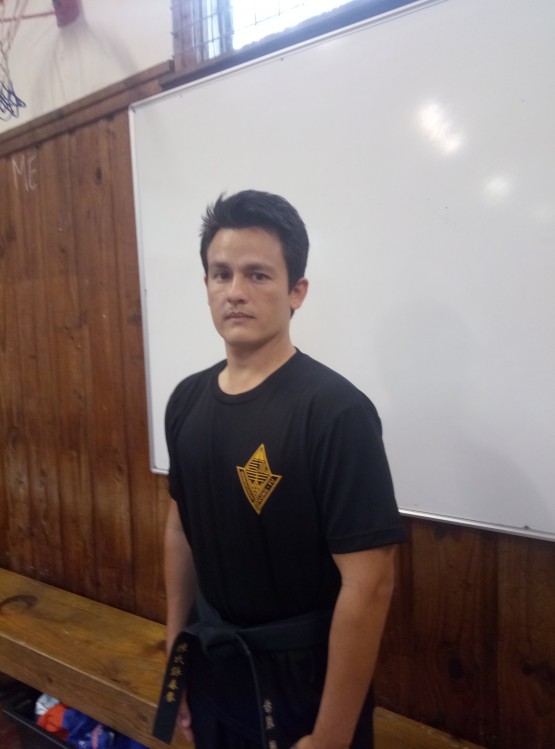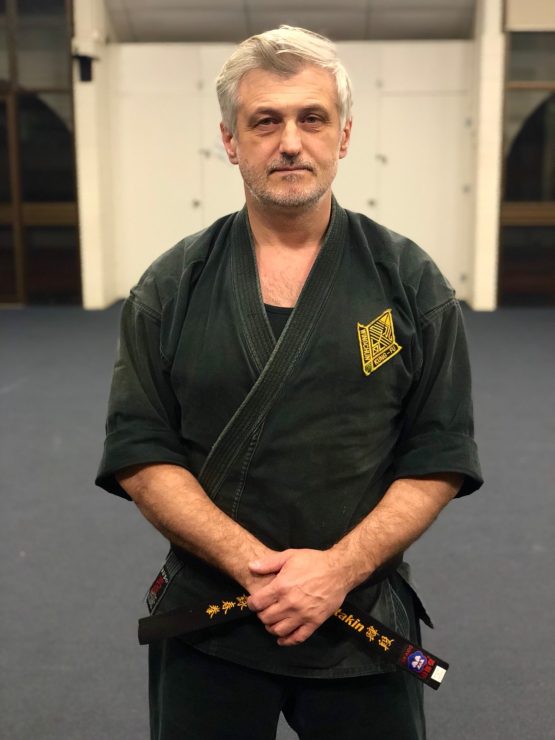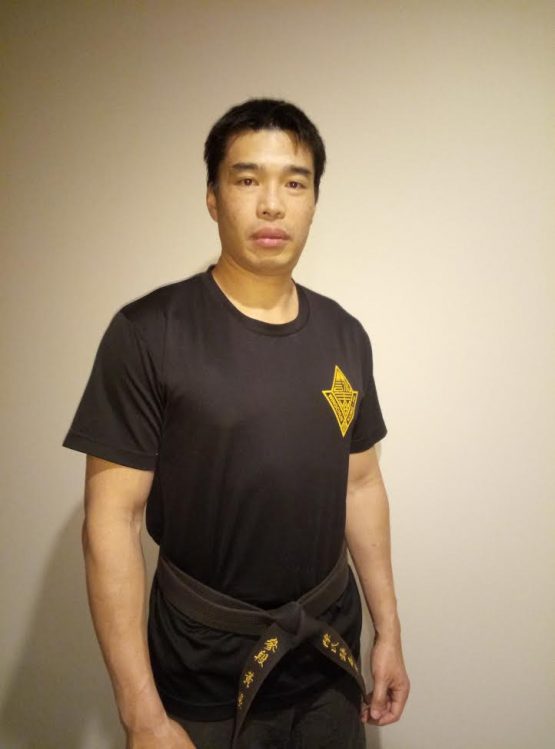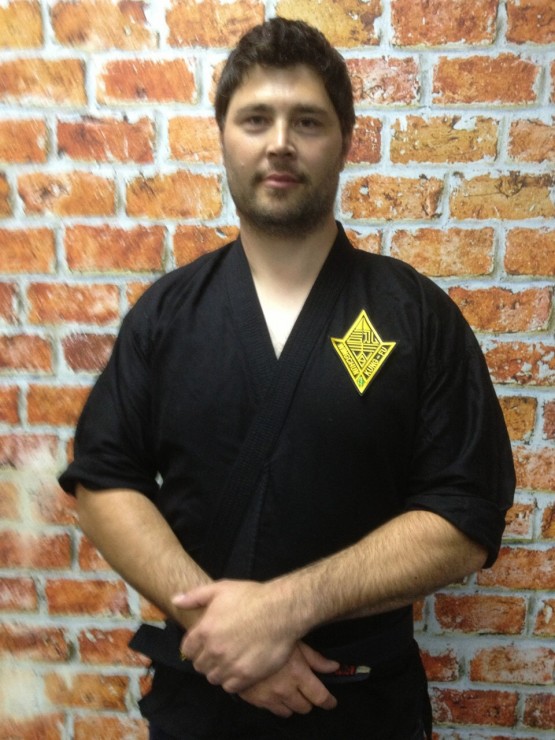Like most Chinese martial arts, the true origin of Wing Chun is cloaked in mystery as facts and
popular fictions are mixed and passed down from teachers to students.
Likewise, the Wing Chun family has spawned a multitude of lineages, each walking its own path
but on the whole they contribute to the rich tapestry of its history.
What is Wing Chun Kuen?
Wing Chun Kuen (詠春拳) is a Southern Chinese martial art that was said to have originated from a Shaolin Nun, named Ng Mui (五枚大师i). Ng Mui fled the destruction of the Northern Shaolin Temple in Henan by the army of Qing Emperor Kang Xi (1662-1722 A.D.), and lived a solitary life in Daliang Mountain. One day she watched a fight between a snake and a crane. She combined their movements with her Shaolin Kung-fu and passed down the art to her disciple, Yim Wing Chun (嚴詠春), whom the art was named after.
Our lineage
Wing Chun entered the modern era in the 19th century when Dr. Leung Jan (梁贊, Liáng Zàn), a Chinese herbalist, combined both Leung Yee Tai’s and Wong Wah Boh’s teachings. He refined the art further with Chinese philosophy and technical depth courtesy of his educated background. The art was then passed down to his son, Leung Bik (梁壁, Liáng Bì ), and a robust disciple, Chan Wah Shun (陳華順, Chén Huá Shùn). Both men were the teachers of Grandmaster Ip Man (葉問, Yè Wèn) who subsequently passed down his art to his nephew, Lo Man Kam (盧文錦, Lǔ Wèn Jiàn), the progenitor of our lineage.
The basic principles of Wing Chun
- Economic movements. This takes away sumptuous moves that often define many Chinese martial arts.
- Correct and natural posture alignment for effective attack and defence, instead of extreme/low stances.
- Efficient movements that conserve energy, in which the fastest travel for a strike or a kick is a straight line.
- Excellent timing, trapping and touch sensitivity, such as the block-attack combinations.
- And practical applications that can maim an opponent quickly and effectively.
NEWS & EVENTS
The followings are recent articles about the school and its events.
We hope these articles can help you understand Wing Chun better while keeping tabs on the latest events.
FORMS & SKILLS
Wing Chun emphasises the importance of the Centreline, balance, relaxation and the harnessing of one’s Qi (氣).
It employs mobile foot works to close a distance gap and fight an opponent in fist-range.
Thus Wing Chun is known as a close-quarter combat style or the art of in-fighting.

Small Idea
The first form “Siu Lim Tao” is the most important and fundamental form of Wing Chun. With the diligent practice of “Siu Lim Tao” through the training of “Sticky Hands” greater sensitivity will be developed. Ultimately achieving spontaneous reaction without thought. To reach this goal patient and prolong practice is a must, it cannot be achieved overnight. The Small Idea Form should take a beginner about two months to learn the basics skills ready for Sticky Hands training.
Seeking Bridge
Wing Chun’s second form Chum Kiu means seeking bridge or bridging hand. It is a way of closing the gap to make contact with your opponent coming in to Sticky Hand range. The use of power is between hand and elbow. It’s application of horizontal forward and back elbow combined with chain palm techniques to shut down your opponent’s hand and elbow attacks. Chum Kiu combines the use of Bong Sau, Chum Sau, Tau Sau and Lan Sau with a strong stance and kicking techniques during attack and defence. Practical application of these techniques require long term practice.
Darting Fingers
Wing Chun’s third form is Biu Sze. It’s use of short and long range attack and defence techniques. Darting fingers power is between finger and elbow. Elbow technique in the third form is vertically from top down, Chinese called Kai. Biu Sze is an extension of the whole hand combine with elbow technique and stance with flexible application. Third form kicking technique especially circling leg focuses on leg power and stance stability. From First form to Third form there are many detail that can’t be explain here, further elaboration will be provided during class times.
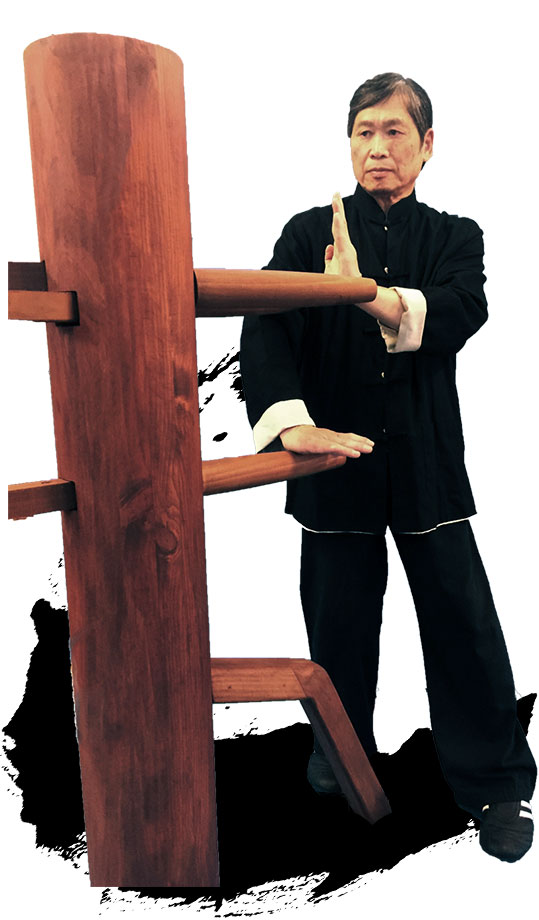
Wooden Dummy
Wooden Dummy is an important curriculum which every Wing Chun student must undertake. After the completion of Small Idea Form, one can begin the study of the Wooden Dummy form. Wooden Dummy form can help determine the right posture, correct transition and angle of one’s stance. Wooden Dummy practice can also improve attacking power. There are many techniques in the Wooden Dummy that can be applied in Sticky Hands. One must remember that the completion of learning the Wooden Dummy form is only the beginning of one’s journey to practical application of these techniques.
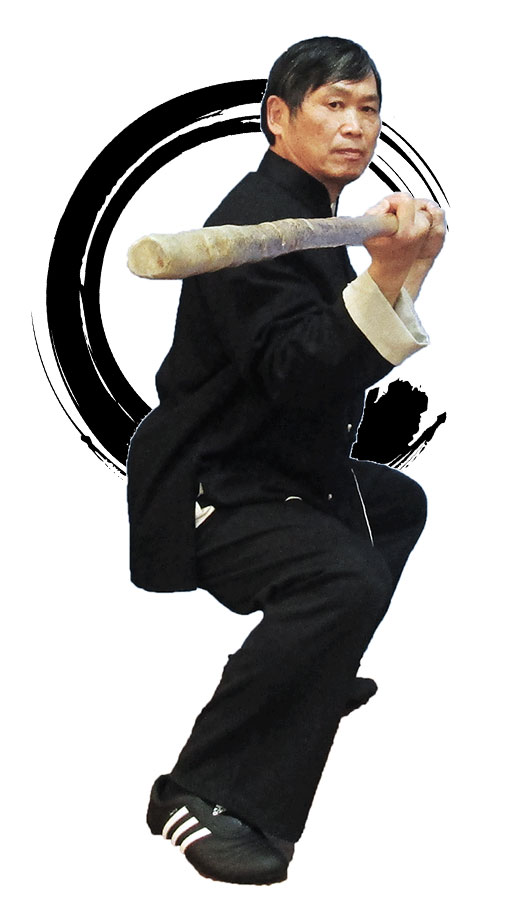
Six-and-a-half Point Long Pole
- Biao Guin
- Jin
- Deen
- Tiao
- Tsin
- Tan
- Din Guin
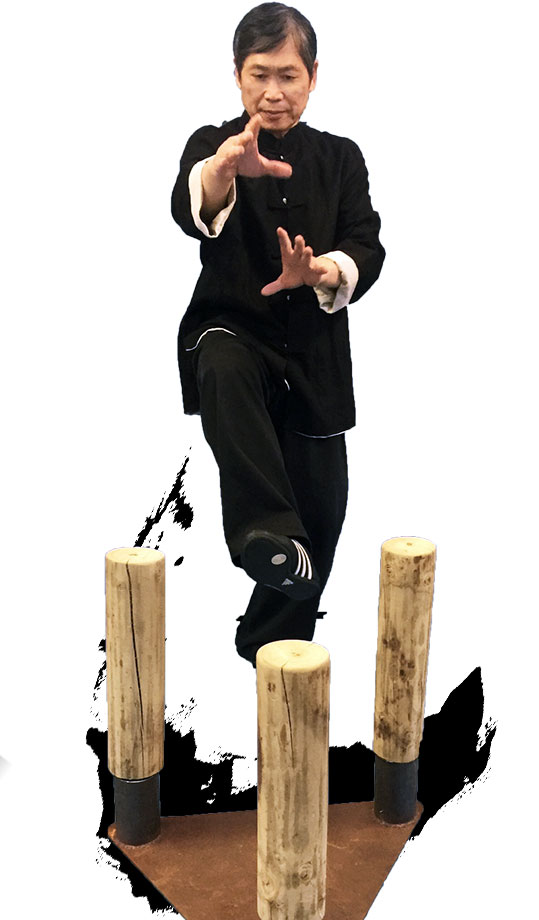
Stance Practice
Wing Chun Stance besides goat stance, also has four horizontal stance, 30/70 stance, bow and arrow stance, Wooden Dummy front facing stance, right side stance and left side stance and one leg stance. Every stance needs to be practice in isolation and held in position for 5 to 30 minutes. Only after long time practice can one achieve power and balance in all stance positions.

Eight Cutting Knife
Eight cutting knife embodies the essence of extension of the empty hand forms. Because the techniques in the knife form almost mirrors those in the empty hand forms. The practice of the knife form and the application of it’s techniques in real situations can dramatically improve sticky hands power, speed and reaction.
The eight cuts are Jar Dao, Biao Dao, Tan Dao, Gan Dao, Kwan Dao, Fan Dao, Faat Dao, Lan Dao.
Besides the practice of the knife form, the most important aspect of Eight Cutting Knife Form is the practical application of the techniques in the form. Also, combining the practice of Wing Chun kicking techniques together with the knife techniques.
It requires a long time in sparring using the knife forms can one reach practical applications of this form.
Butterfly Double Sword
The Bufferfly Sword form is not included in the Wing Chun system. This form differs from Wing Chun Eight Cutting Sword form in their movement and technique. Bufferfly Sword include many jumps and turns of 180 degrees. The composition and form of the Bufferfly Sword resembles the Wing Chun Eight Cutting Sword. Therefore, the techniques of the Bufferfly Sword will compliment the Wing Chun Eight Cutting sword techniques. One who is proficient with the Wing Chun Sword techniques will find increase applicability of these techniques.
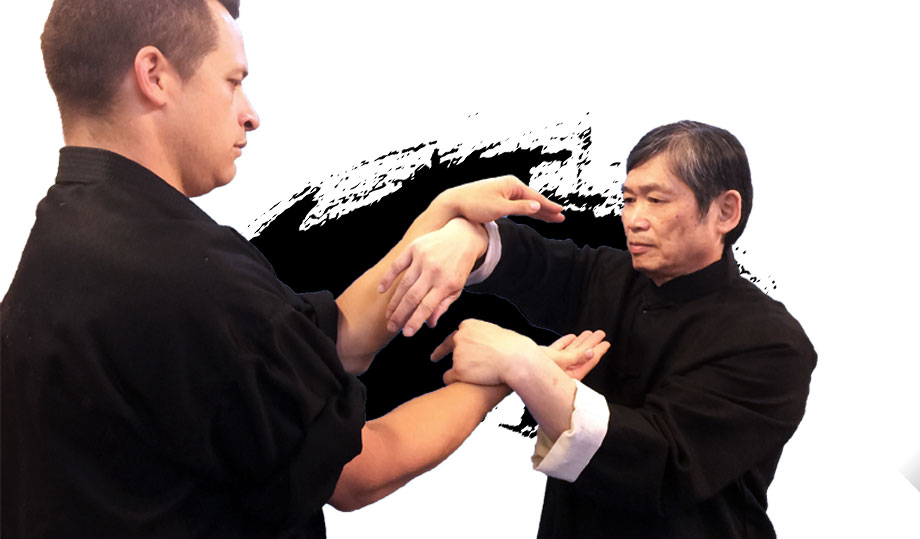
Sticking-Hands
What is sticky hands? It can be interpreted as a high standard of interpersonal conduct and moral principle for treating others. Every Wing Chun student should know that stick hands is not to control and win over your training partner or worst still to hurt your training partner. More importantly, during sticky hands practice, every one should respect each other. Through hand to hand contact using the techniques one has learnt in the forms and basic drills to apply it without thought or sight to react and respond naturally.
Why do we say that stick hands can be interpreted as moral principle of treating others, because through sticky hands contact, we learn to communicate with each other not through brute force or violence imposed on your training partner but with mutual respect and to learn from each other. Only then can we achieve inner peace.
There are many important points that can not be covered here. These will be elaborate and explained in more detail during class and practice times.
Blind folded Stick Hands
Blind folded stick hands is one of the basic training of Sticky Hands. When beginning sticky hands students can start to practice more blind folded sticky hands. This training is used to increase sensitivity and reaction speed during practical applications. But blind folded sticky hands is restricted for only use when there is contact.
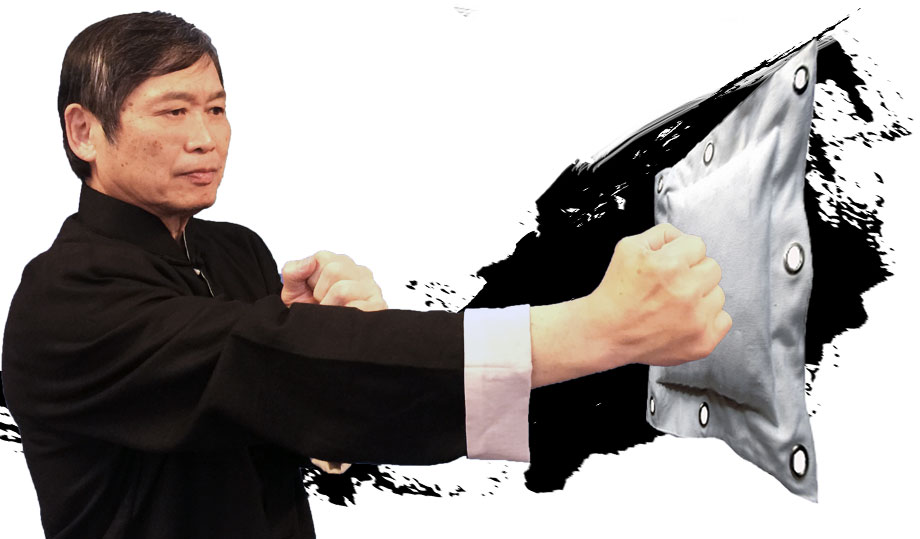
Wing Chun Wall Bag
Wing Chun sand bag is usually held against a wall. The wall bag is divided in to three sections vertically. The upper section is used to practice straight punch, elbow, palm strikes, and cutting hand. The middle section is used to practice low palm strikes. The lowest section is used to practice kicking techniques.
Wing Chun wall bag practice is primarily for power. When starting wall bag practice first begin with light strikes and increase power over time. Also take care not to hurt the bones and joints. When generating power use hip and stance together. Power comes from the rooting principle of proper stance.
Martial Arts Ethics
The first prerequisite of a person seeking martial arts skills is to learn the ethics of martial arts. Someone who is highly skilled in technique but lacks martial arts ethics will be harmful to others, to society and country.
What is martial arts ethics? It is having kindness, righteousness, respect, integrity and courage. These are required traits for any martial artist for living their daily life, for treating others, for choosing a disciple and in seeking a teacher. For anyone passing on their martial arts skills must abide by martial arts ethics.
Having humility, respect elders, having integrity, avoid drunkenness, these characteristics must be adhered to in choosing a disciple or seeking a teacher. A person desiring to possess martial arts skills must put ethics first. No skills can be passed on to anyone who does not possess martial arts ethics.
A martial artist must behave in an ethical way in their speech. Should not hurt others and should not gossip. Martial artists must possess ethical traits in their action toward others. When sparring should have self control. Do not use one’s martial arts skills lightly.
A martial artist must be ethical toward society and country. Abide by the law of the land. Use one’s martial arts skills to help others, to be just and help the weak. Be courageous in doing what is right.
A martial artist must have posses character of loyalty, honesty, courage and love of country. Martial arts ethics is a long held Chinese tradition and is valued above all else as the highest guidance and direction for a martial artist. It is the common code of conduct among martial artists. Therefore, before learning any martial arts skills one must first learn the ethics of martial arts. The principal of martial arts is to do what is good, don’t fear evil and help the weak.
All martial artist should abide by these values.
CLASSES & TIMETABLES
Our teaching method is rigorous but friendly and fun.
We have many outstanding instructors who teach throughout the Auckland region.
Friday 7:00 – 8:30pm
Kids Class: 5.30pm to 6.30pm
Adults: 6.30pm to 8.00pm
James Centre – School Hall, Broadbeach State School,
Old Burleigh Road, Broadbeach.
Burleigh Heads Community Center, Corner of Ocean St and Park Ave, Burleigh.
You can contact us or directly contact Sifu Bruce Cheng at:
- Mobile: 021-1381828 or email Sifu Cheng.
Note: Sifu Bruce Cheng can converse in English, Mandarin, Cantonese and Hokkian.

GET IN TOUCH!
We would love to hear from you.
Please use the form below to send us a comment or ask a question.
We will reply as soon as possible.
“I have been practising martial arts for more than 45 years. In those 45 years I have learned many different styles of martial arts but in the end, Wing Chun is the one I stayed with. Wing Chun has the advantage of being easy to learn; it can be “soft”, “hard” or both, it fits the human physique and it is also safe to practice. The practitioner will benefit from the physical fitness and learn the techniques for self defence. Expertise can be obtained if the practitioner can maintain the practice routines. Learning from a good Master is also a must.“ ~ Bruce Cheng ~
Address:
Bruce Cheng Martial Arts
c/o Sifu Bruce Cheng
P.O. Box 128119, Remuera
Auckland, New Zealand
Phone number:
Mobile: 021-1381828
E-mail:
bchengwingchun@gmail.com
Social links:
